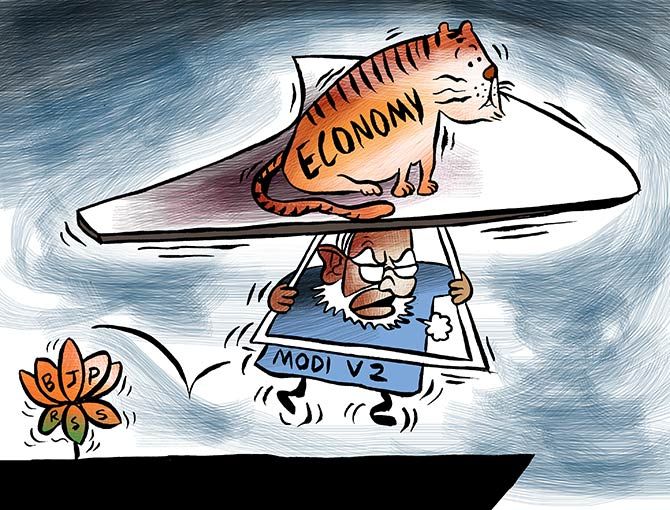The Bankruptcy Code and the GST are a good start. But reforming land, labour, power, and the financial sector is now imperative, says Sajjid Z Chinoy.
Illustration: Uttam Ghosh/Rediff.com

To appreciate India’s economic challenge, one has to realise that if growth in April-June prints below 6 per cent again -- as we expect it will -- this would be the first time in almost seven years that growth has printed below 6 per cent for two successive quarters.
The last time this happened was in the run-up to the 2013 taper tantrum, when India’s internal and external imbalances were dragging activity down.
It’s tempting to characterise India’s slowdown as either “externally induced” or “structural”.
The first would imply there is very little policymakers can do, because a falling global tide is depressing all boats.
The second would imply there is no role for any counter-cyclical policy response.
We would argue the data conform to neither of these characterisations.
While India’s growth slowed to 5.8 per cent in the January-March quarter, creating a sticker-shock for the markets, it wasn’t because of slowing external demand.
Exports grew at nearly 11 per cent that quarter, reflecting a strong first quarter globally.
To be sure, global growth has since slowed precipitously as the uncertainty-magnifying effects of the trade conflict dampen business sentiment around the world.
Exports are therefore expected to weigh on growth in the coming quarters.
But while they may compound the slowdown, they weren’t its genesis.
Some argue that India is in the midst of a “structural consumption slowdown”.
But this is not borne out by the data.
Private consumption growth has averaged almost 8 per cent for the last four years, and has begun to slow only in recent quarters, albeit sharply, suggesting there is nothing structural about its slowing yet.
Instead, consumption began to slow after the IL&FS mayhem led do a shutdown of the NBFC sector, which had financed (unsustainably so, one could argue) much of the recent spurt in consumption.
With public sector banks constrained by capital and still working through their NPA woes, they were understandably risk-averse to jump in and fill the gap.
The continually worsening agrarian terms of trade further hurt rural purchasing power, and with the auto sector experiencing meaningful, though idiosyncratic, stress, consumption came up against the perfect storm.
The fact that the slowdown has a cyclical component to it is also evident in the evolution of core inflation.
The annualised momentum of core-core inflation was 6 per cent in the second half of 2018 but dramatically slowed to less than 3 per cent in 2019, suggesting a sharp drop-off in pricing power and confirming output gaps have opened up.
What should the countercyclical response be?
With headline and core inflation falling meaningfully, some space for monetary easing has opened up.
The question is: How efficacious will monetary easing be?
Until the financial system is repaired, the transmission of monetary policy is likely to be limited.
Despite multiple rate cuts and a deluge of interbank liquidity, a large chunk of NBFCs are still being rationed out.
The binding constraint hasn’t been liquidity or the cost of capital.
Instead, the source of lenders’ risk aversion has always been asymmetric information about the underlying asset quality of NBFCs.
Without some sort of “asset quality review” by regulators, the logjam is likely to continue, we think.
Bank credit growth, too, has slowed sequentially, suggesting heightened risk aversion by banks as they reassess risk against the backdrop of rising household debt, and some public sector banks still face capital constraints.
Therefore, even as risk-free rates have gone down, credit spreads have gone up.
All told, even as monetary policy has been eased, the plumbing (financial sector) is partially choked, leading to limited transmission.
In this environment, excessive easing may not do much to the real economy, but simply increase the risks of an asset price bubble.
Calls have renewed for more “fiscal stimulus”. This would be counterproductive.
Public sector borrowing (8-9 per cent of GDP) is consuming all household financial savings (7-8 per cent of GDP).
These pressures have pushed up the term premium, keeping the cost of capital higher than it needs to be.
Any fiscal stimulus at this stage would simply result in bond yields and quasi-sovereign spreads firming (potentially sharply), which will further impede the transmission of monetary policy.
Similarly, policymakers must resist calls to constantly tinker with GST rates.
Finally, it’s important to ensure monetary conditions are not inadvertently tightened by letting the exchange rate appreciate.
India’s bilateral merchandise trade deficit vis-à-vis China has increased over the last 15 years.
Things haven’t been helped by the rupee appreciating 18 per cent in real terms vis-à-vis the CNY (Chinese yuan) over the last five years.
With the CNY breaching the psychologically important threshold of seven against the US dollar last week, and more depreciation expected as trade tensions deepen, it’s important the rupee be allowed to depreciate in tandem with the CNY.
But the economic challenge isn’t limited to just a demand slowdown.
Business sentiment and “animal spirits” are flagging, which can’t be reversed by just reducing the cost of capital.
So what can the government do in the near term?
How about doubling down on asset sales through a bold and decisive plan to privatise and strategically divest?
Not only will this signal reform intent, but alleviate fiscal concerns while creating resources for a public investment injection, and attract foreign interest for some of these assets.
In the near term, the focus must be to fix the financial plumbing to allow monetary policy to transmit better, ensure India’s exchange rate remains competitive, sell assets more aggressively (as a visible down-payment of reform intent), and exhibit strategic fiscal restraint.
But the medium-term challenge is perhaps more daunting.
Growth has been driven in recent years by debt-fuelled consumption by households (which cannot sustain beyond a point) and the positive terms of trade shock from the collapse in oil prices.
Externally, with the trade war deepening and protectionism rising, the global economy will pose more headwinds than tailwinds.
All this has only one implication. For growth to sustain close to 7-8 per cent in the medium term, the economy will need another wave of reforms.
The Bankruptcy Code and the GST are a good start.
But reforming land, labour, power, and the financial sector is now imperative.
Sustained growth cannot be driven by a fiscal stimulus or a monetary stimulus. Only through a reform stimulus.
Sajjid Z Chinoy is chief India economist at J P Morgan. All views are personal.












 © 2025
© 2025